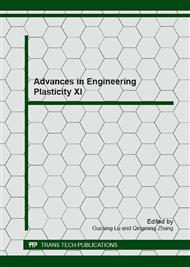p.457
p.461
p.465
p.469
p.473
p.477
p.481
p.485
p.489
Deformation Mode Dependency on Strain Rate Sensitivity of Volume Resistivity in TRIP Steel
Abstract:
With a phenomenon of strain-induced martensitic transformation, TRIP steel is expected to show excellent impact energy absorption characteristic. It is important for an improvement of a reliability of TRIP steel to evaluate an amount of martensite. In this study, AISI304, which is a kind of TRIP steel, is deformed plastically by a conventional material testing machine and the split Hopkinson pressure bar apparatus. During the deformation of TRIP steel, a circuit based on the Kevin double bridge measures change in volume resistivity which has a correlation with the amount of martensite. Experimental results show that the change in volume resistivity during the process of deformation at various strain rates.
Info:
Periodical:
Pages:
473-476
Citation:
Online since:
January 2013
Authors:
Price:
Сopyright:
© 2013 Trans Tech Publications Ltd. All Rights Reserved
Share:
Citation:


